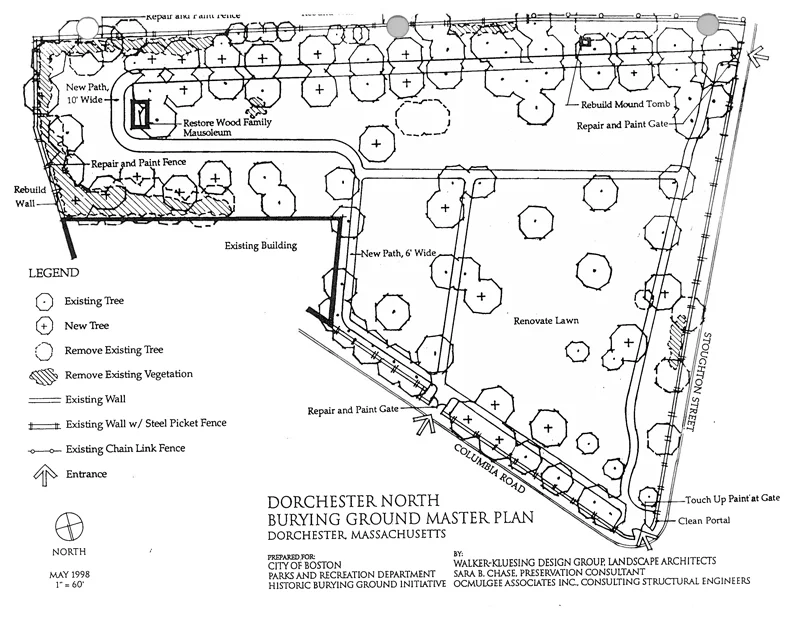









Designated in 1634, DNBG is one of America’s oldest cultural landscapes and heritage sites. Nearly four hundred years old, its L-shaped property contains 3.19 acres of green space and approximately 2,600 surviving grave markers that reside latent in Uphams Corner.[1] Formerly Cemetery Corner, Uphams Corners' commercial district surrounds DNBG at the junction of Dudley Street, Stoughton Street, and Columbia Road in Dorchester, Boston. Challenges that face this unique culturally-enriched community include poverty, youth violence, housing, and an increase in single-parent families. This creates great demand for developmental landscapes that bridge economic, cultural, and generational boundaries, such as Dorchester North Burying Ground.[2]
Throughout New England, historic municipally-owned burying grounds often suffer neglect and under-utilization, despite their significant value as cultural landscapes and open spaces situated in the heart of cities. Since they are full and inactive, they no longer produce income and have difficulty competing for budget funding.[3] As more cemeteries become full, they will shift from private to public ownership, and continue to face funding hurdles. For example, between 2003 and 2008, 11 abandoned private cemeteries in New York City were legally transitioned into the city’s Department of Parks and Recreation.[4] OPEN UPHAMS researches how creative adaptation and participation, through educational programs and cultural events, may thrive within inactive burying grounds, like DNBG. We believe these public spaces are open resources for living communities to learn from the past and celebrate the present.
SOURCES: [1] “Report and Inventory Volume I Dorchester North Burying Ground.” Boston: Historic Burying Grounds Initiative, 1986: 1, 18-19. [2] Jones, Tamecia and Rudy Mitchell. “Uphams Corner Neighborhood Briefing Document.” Boston: Youth Violence Systems Project, 2008: 9-19. [3] “Preservation Guide for Municipally Owned Historic Burial Grounds and Cemeteries, Third Edition.” Massachusetts: Department of Conservation and Recreation and Executive Office of Energy and Environmental Affairs, 2009: 12. [4] Harnick, Peter & Aric Merolli. “Cemeteries Alive: Graveyards are resurging as green spaces for the public.” Landscape Architecture. December 2010.
Designated in 1634, DNBG is one of America’s oldest cultural landscapes and heritage sites. Nearly four hundred years old, its L-shaped property contains 3.19 acres of green space and approximately 2,600 surviving grave markers that reside latent in Uphams Corner.[1] Formerly Cemetery Corner, Uphams Corners' commercial district surrounds DNBG at the junction of Dudley Street, Stoughton Street, and Columbia Road in Dorchester, Boston. Challenges that face this unique culturally-enriched community include poverty, youth violence, housing, and an increase in single-parent families. This creates great demand for developmental landscapes that bridge economic, cultural, and generational boundaries, such as Dorchester North Burying Ground.[2]
Throughout New England, historic municipally-owned burying grounds often suffer neglect and under-utilization, despite their significant value as cultural landscapes and open spaces situated in the heart of cities. Since they are full and inactive, they no longer produce income and have difficulty competing for budget funding.[3] As more cemeteries become full, they will shift from private to public ownership, and continue to face funding hurdles. For example, between 2003 and 2008, 11 abandoned private cemeteries in New York City were legally transitioned into the city’s Department of Parks and Recreation.[4] OPEN UPHAMS researches how creative adaptation and participation, through educational programs and cultural events, may thrive within inactive burying grounds, like DNBG. We believe these public spaces are open resources for living communities to learn from the past and celebrate the present.
SOURCES: [1] “Report and Inventory Volume I Dorchester North Burying Ground.” Boston: Historic Burying Grounds Initiative, 1986: 1, 18-19. [2] Jones, Tamecia and Rudy Mitchell. “Uphams Corner Neighborhood Briefing Document.” Boston: Youth Violence Systems Project, 2008: 9-19. [3] “Preservation Guide for Municipally Owned Historic Burial Grounds and Cemeteries, Third Edition.” Massachusetts: Department of Conservation and Recreation and Executive Office of Energy and Environmental Affairs, 2009: 12. [4] Harnick, Peter & Aric Merolli. “Cemeteries Alive: Graveyards are resurging as green spaces for the public.” Landscape Architecture. December 2010.